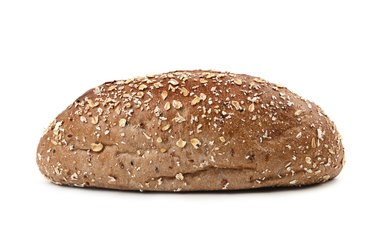
Not all flours are created equal. The protein content of wheat flour can vary from 5 to 15 percent, and this variance can greatly affect your recipes. Alternative flours, made from ground legumes or soy, may also offer a high protein content, but a flavor that may not please your palate.
Wheat Flour
Video of the Day
High-protein wheat flour may bear the label "high protein" or "bread flour." This type of flour provides 362 calories per 100 grams, with 1 gram of fat, 70 grams of carbohydrates and 15 grams of protein. Compare this to cake flour, which contains just 8 grams of protein per cup. Use high-protein wheat flour to bake crusty loaves of bread with a chewy center. High-protein wheat flours create dense, brick-like cakes, quick breads and muffins, however. Wheat flour protein is not complete, meaning it lacks some of the essential amino acids found in complete protein sources such as eggs and meat.
Video of the Day
Soy Flour
Soy flour contains no gluten, so it is appropriate for people on a gluten-free diet. It comes from soy beans and usually has some of the fat removed to prevent quick spoilage. One cup, approximately 100 grams, of de-fatted soy flour provides 329 calories, 1 gram of fat, 38 grams of carbohydrates and 47 grams of protein. You may use up to ¼ cup of soy flour to replace an equal amount of wheat flour in baked goods, but replacing all of the wheat flour in breads or muffins will significantly change the texture, appearance and taste of the final product. Soy flour's flavor is better suited to dredging meats or vegetables before sautéing or for thickening sauces. The protein in soy flour is complete, meaning it offers all nine of the essential amino acids. Soy flour also offers the benefits of isoflavones that may protect against heart disease and alleviate symptoms of menopause.
Garbanzo Bean Flour
Garbanzo bean flour, also called chickpea flour, comes from ground, dried garbanzo beans. The flour is gluten-free and most often appears in Indian bread and sauce recipes. One cup of garbanzo bean flour, weighing about 120 grams, contains 440 calroies, 8 grams of fat, 72 grams of carbohydrates and 24 grams of protein. Garbanzo bean flour has a distinctive taste and cannot be used as a direct substitute for wheat flour. The protein is not complete.
Additional High-Protein Flours
Buckwheat flour is not related to wheat, and offers 13 grams of protein per cup. Use buckwheat flour together with wheat to make pancakes or as a gluten-free alternative to wheat flour to thicken sauces. Quinoa flour, made from ground quinoa seeds, has 16 grams of protein per cup. You can use quinoa flour to replace a small amount of wheat flour in recipes or to make homemade pasta. Quinoa flour is more calorie dense than wheat, soy or buckwheat flour. If you use any gluten-free high-protein flour in baking, you will need to adjust baking times, ingredients and methods to adjust for the lack of gluten.